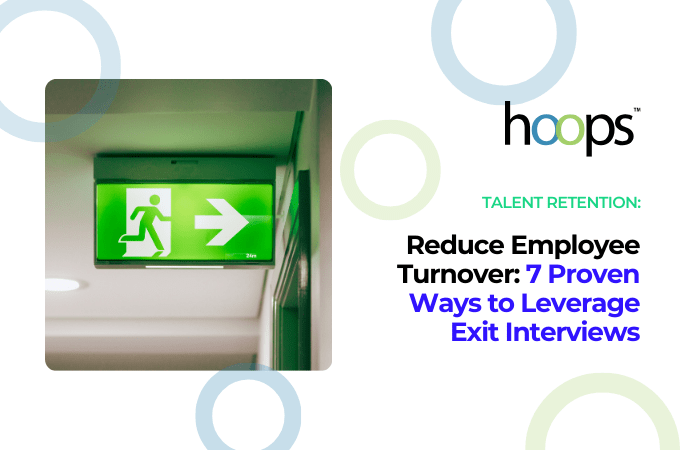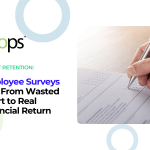Let’s Talk About Your Leaky Bucket
You wouldn’t ignore water pouring out of a hole in a bucket—so why do so many companies ignore the insights of departing employees?
Most businesses conduct exit interviews. But very few leverage them.
Exit interviews are one of the most underutilized tools to reduce employee turnover, improve engagement, and protect your revenue pipeline. So why aren’t more companies taking them seriously?
The Cost of Getting it Wrong
Here’s what’s at stake: Gallup estimates it costs about 200% of salary to replace leaders and managers, 80% for technical pros, and 40% for frontline workers (or more). And yet, 42% of voluntary exits were preventable—but no one intervened.
Turnover isn’t just disruptive—it erodes institutional knowledge, delays projects, damages morale, and drains your budget (read more about the true cost of turnover). Too many organizations treat exit interviews as an afterthought, when they should be a first line of defense against costly, avoidable attrition.
At Hoops, we believe exit interviews shouldn’t be a checkbox—they should be a strategic weapon in your toolkit to reduce employee turnover.
1. Clarify the “Why” to Encourage Honest Feedback
Exit interviews won’t work if employees don’t trust how their feedback will be used. Too often, they’re viewed as a formality—something HR checks off without any real follow-up. That perception leads to vague, guarded, or sugar-coated responses.
On top of that, many employees fear their honesty could hurt their reputation or future references. Others believe nothing will change based on what they say.
It’s your job to make it crystal clear that none of that is true—and that their feedback will remain confidential, be used constructively, and help others.
Action: Frame the exit interview as an approachable and anonymous legacy-building opportunity.
- Send a short pre-interview email that explains how their feedback will inform real retention strategies and shape future team experiences.
- Start each interview with a clear preamble (verbally and in writing) that reassures them, like: “Your feedback helps us improve. It won’t affect future references and will only be reviewed by [neutral party/team]. We want your honesty—not for blame, but for growth.”
Trust sets the tone. And without trust, there’s no real data—just noise.
At Hoops, we build that trust into every offboarding workflow, with secure, role-based access and anonymized reporting that encourages transparency and delivers actionable insights.
2. Ask Targeted Questions That Uncover Why People Really Leave
Vague exit surveys lead to vague solutions. To reduce employee turnover, you need targeted questions that cut through surface-level dissatisfaction and highlight the issues most strongly tied to retention—like recognition, greater work-life balance, or career development.
Not all low scores are worth chasing. For example, “benefits” might be rated poorly, but if it’s not driving resignations, it shouldn’t be your priority. Focus instead on what’s actually driving people to leave—at your company specifically.
💡 Did You Know?: According to a recent Gallup study, the most common themes for leaving a job in 2024 included “Engagement and Culture” (37%) and “Wellbeing and Work-Life Balance” (31%), followed by “Pay and Benefits” (16%) and “Managers and Leaders” (9%). Note that these are general cross-industry averages, and the best strategies will come from direct employee input.
Action: Ask a mix of multiple-choice (for scoring/analytics) and free response questions that dig deeper, like:
- Multiple Choice: “Which of the following issues best describes your primary reason for leaving this role? Please select all that apply.”
- Multiple Choice: “Which of the following factors could have convinced you to stay? Please select all that apply.”
- Free Response: “Was there a turning point when you started considering leaving? What happened?”
- Free Response: “How supported did you feel by your manager over the past 90 days? How come?”
Hoops helps you build strategic, role-specific exit questionnaires and uses analytics to recognize patterns that highlight which responses are most predictive of future turnover. For instance, if low scores on manager communication directly correlate with regrettable exits, we help you turn that insight into targeted leadership development, taking out the guesswork.
3. Segment Feedback by Regrettable vs. Non-Regrettable Turnover
Not all turnover hurts. But losing your high-performers? That’s costly. By separating exit responses into regrettable (people you wish stayed) and non-regrettable categories, you can compare patterns—and zero in on what’s really costing you.
Action:
- Tag exits based on performance or future potential
- Analyze which drivers (e.g., poor leadership, lack of growth) show up more in regrettable losses
- Prioritize fixes for what matters most
Hoops’ platform allows for easy filtering and analysis across regrettable loss categories—connecting insights to action in one place.
4. Convert Exit Trends into Proactive Stay Interviews
Why wait until it’s too late? Exit interviews are a goldmine for improving your stay interview strategy. If multiple exits mention poor communication or limited growth, start asking your current team what factors would help keep them at your company.
Action: Create a feedback loop:
- Identify recurring themes in exits (e.g., lack of development)
- Add proactive versions of those questions into your stay interviews (e.g. “What kind of development opportunities would make you want to continue to grow with us?”)
- Track which managers or teams may be showing early warning signs
Hoops helps you close the loop between exit, engagement, and stay data through custom automation workflows and personalized surveys. We turn those insights into proactive, high-impact stay interviews—so your retention strategy feels intentional, not reactive.
5. Track Patterns by Manager, Department, and Role
You can’t reduce turnover without knowing where it’s concentrated. Looking only at company-wide data hides problems that are actually team-specific.
Action: Break down your exit data by:
- Manager: Are certain leaders consistently flagged for poor support?
- Role: Are specific positions prone to early turnover or lacking purpose-driven work?
- Location or department: Is there a cultural mismatch in a region or department team?
With Hoops’ technology and tools, you can visualize these insights and link them directly to performance, helping you make smarter investments in training or culture interventions.
6. Spotlight Strengths to Support Retention and Employer Brand
Exit interviews aren’t just about what went wrong. They also tell you what’s going right—which you can double down on to retain current employees and attract new ones.
💡 Did You Know?: SHRM’s 2025 State of the Workplace report notes that 83.4% of employees value a positive work environment, making it a key retention driver.
Action: Ask questions like:
- “What did you most enjoy about working here? Please select your top three reasons.”
- “What should we continue doing more of as a company? Please select your top three recommendations.”
Use this insight to:
- Reinforce what’s working internally (e.g., flexibility, team camaraderie)
- Fuel employer branding content (careers pages, job posts, social media, etc.)
- Coach (and reward) managers on what they’re doing well
Even small wins, like a shoutout to team culture, can become powerful retention drivers when consistently reinforced.
7. Build a Quarterly Retention Action Plan Based on Exit Insights
Collecting exit feedback is step one. The real ROI comes from applying it.
Action: Every quarter, use exit data to create a 3-part action plan:
- Fix: One issue to improve (e.g., manager communication)
- Enhance: One strength to double down on (e.g., onboarding)
- Monitor: One trend to watch (e.g., recognition feedback scores by team)
💡 Need a headstart? Here are 10 employee retention strategies that can make a real difference.
Hoops helps you translate exit themes into measurable action steps—and gives you the tools and team to track progress, adjust strategy, and reduce employee turnover over time.
Bottom Line: Don’t Let Exit Interview Insights Go to Waste
Turnover isn’t just an HR issue—it’s a business risk. Done right, exit interviews help you fix what’s broken, build on what’s working, and make sure your best people don’t become someone else’s top hire.
And if you need it, Hoops is here to help you listen better, act faster, and keep the people who power your business.
Exit interviews are just one part of a healthy talent strategy to reduce employee turnover. Want to know how your overall approach stacks up? Take our free 2-minute Talent Health Checkup to uncover hidden gaps in your retention and talent strategy.
Simplify hiring. Amplify growth. Let’s build your winning team together!







